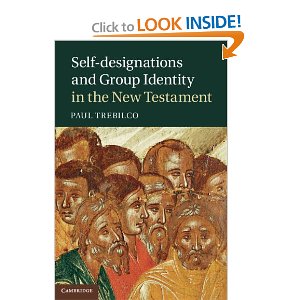The technical label fictive kinship is one a person frequently encounters in sociological literature when one is talking about a group that talks to and about each other as if they were family when in fact they are not physical kin. My problem with applying this technical phrase to the ‘family of faith’ language we find in the NT, is that it appears to me that Paul and others really believe there is such a thing as a spiritual kinship involved for those who are a part of the body of Christ (to use another metaphor). In other words, we are not talking about a fiction, legal or otherwise. We are talking about a different sort of reality than physical kinship. Whatever we think about this issue, there can be no doubt that the brother and sister language tells us significant things about the earliest Christians and how they viewed and talked about themselves.
As Trebilco shows, of the some 271 occurrences of the brother language used metaphorically of fellow believers (both male and female) only 2 NT books don’t reflect this usage— Jude, and oddly, Titus. It is used both at a term of address and also as a designation. Like most of these labels there is a background or pre-history to their usage. Not only is this terminology found occasionally in the Greco-Roman world (see Epictetus Dia. 1.13.4) it is found rather frequently in the LXX of fellow Israelite believers (see Deut. 3.18; 15.2-12;22.1-4 etc.). Of course in the NT, the term basically does not mean fellow Israelite, it means fellow follower of Christ, so without question we see the basic sectarian nature of early Christianity. Only it’s in group of people who believe in Christ are called brothers or sisters. Not all Jews in general.
One of the things that makes this interesting and significant is that siblings in the Greco-Roman world were regularly seen to be the closest of family kin, and so now the terminology is used to refer to the closeness of believing kin. Plutarch for example has a whole treatise on brotherly love as the most significant kind of love (see Frat. Amor. 480B). While adelphe is sometimes used by Paul (Rom. 16.1,1 Cor. 7.15; 9.4-5; Philemon 2) most often adelphos is used and used inclusively of both genders, though sometimes ‘brothers’ is used as a term to address just males (1 Thess. 4.3-8). One can sometimes tell something about the level of intimacy between an author and an audience by the frequency of the use of this language. So, for example brother language is very frequent in 1 Thessalonians, but less so in Romans, when Paul is writing to a congregation that he did not convert. On the other hand, sometimes the terminology is used to good rhetorical effect to apply a certain amount of pressure on the audience to behave like family (see Romans 14-15).
Trebilco is aware of and agrees with the notion that ultimately it is Jesus’ own use of this sort of language with his disciples (Mk. 3.31-35) that probably helped spawn the use of it by the earliest Christians after Easter. Their is a radicality in the use of this language rightly pointed to by Trebilco, quoting John Barclay….”Family members who broke with ancestral traditions on the basis of their new-found faith showed an appalling lack of concern for their familial responsibilities. Christians deserted ancestral practices [e.g. like burying family members], passed on since time immemorial for a novel religion ….The exclusivity of the Christian religion–their arrogant refusal to take part in,or to consider valid, the worship of any God but their own–deeply wounded public sensibilities.” (p. 43).
Trebilco is able to demonstrate that the use of this sort of language likely goes back to the earliest period of Christianity, even before Paul wrote his letters, a fact not surprising since Jesus (and the OT) had provided precedent for such usage. What is new of course, is that when Gentiles became followers of Jesus, it became clear that the term ‘brother’ no longer had an implied ethnic component. This made the usage different than what one finds in the OT. Luke demonstrates the transition from using it just of Jewish Christians (those ethnically Jewish), to using it of Gentile Christ followers in Acts 15…. perhaps hinting that the Jersalem council played a role with its decrees in the broadening of the usage to include Gentile Christians (see Trebilco p. 53). Trebilco concludes that the high freqquency of the use of this language right across the NT (with the two noted exceptions) testifies to one of the distinctive and distinguishing features of early Christianity— their powerful experience of community as a new family, which set them apart from other religious groups, and indeed from other concepts of family. (p. 66)












